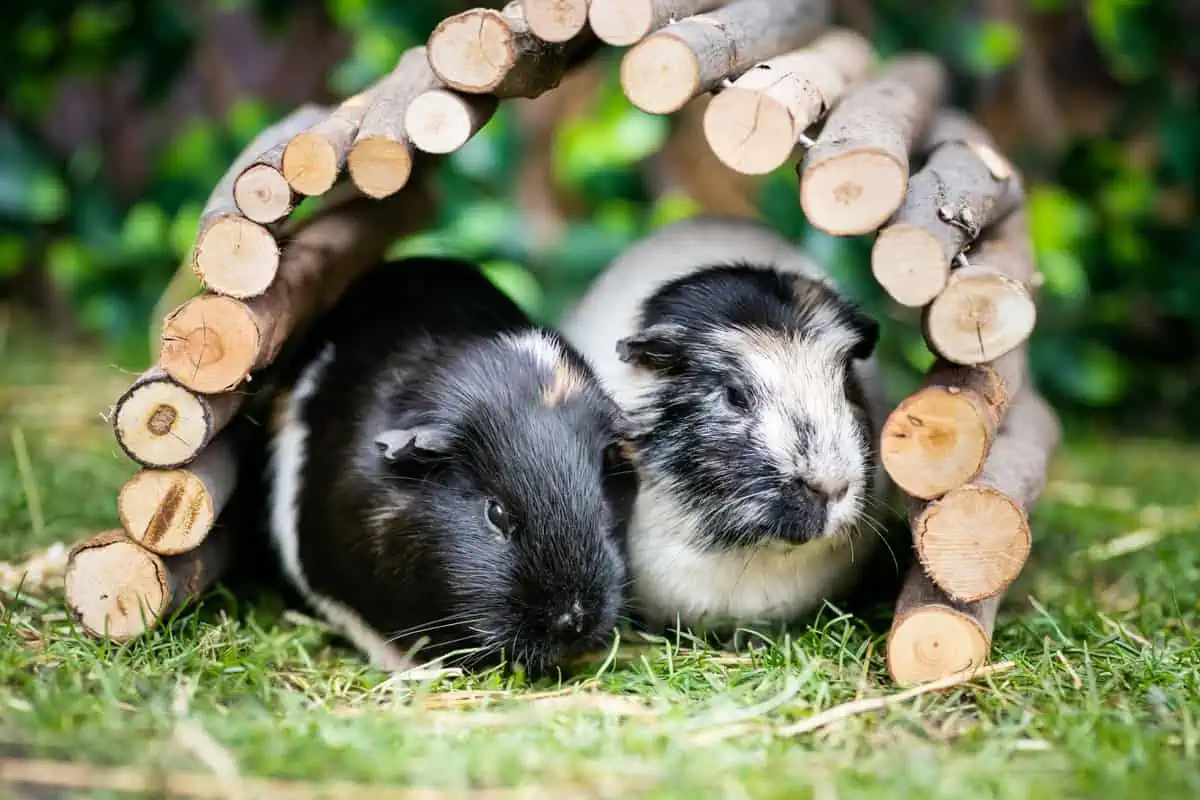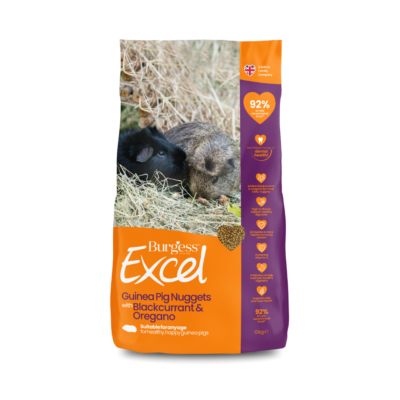
A solo guinea pig is unlikely to be a happy guinea pig. As highly social animals, guinea pigs need company of their own kind and should ideally always be kept in same sexed pairs or small neutered groups (never with other species such as rabbits).
However, if you’ve decided to bring home a new guinea pig pal as a companion to your existing piggy, be aware that a successful introduction process takes time and patience.
The first rule of guinea pig introductions is to never put them together straight away. After all, how would you feel if a complete stranger suddenly invaded the safety of your home?
It’s just the same for shy, sensitive guinea pigs. Building a good relationship takes time and it’s really important that things get off on the right foot.
TOP TIP!
Before you start looking for a new piggy pal, make sure you know the sex of your existing guinea pig (ask your vet to check if you’re not sure). If you have a male, it’s best to get a neutered female. In the wild, guinea pigs would have just one mature male in a group and putting two boys together who are not from the same litter will likely result in a fight. If you have a female guinea pig, a neutered male may be better than another female – girls can be just as territorial with each other as boys.
How to build a good guinea pig relationship, step by step
1. FIRST IMPRESSIONS – THE BONDING PROCESS STARTS HERE
Start by putting your guinea pigs’ homes and runs close enough so that they can see each other but are still separate. Keep this arrangement for at least three days. This allows the piggies to see, smell and sit with each other, while keeping them safely apart.
2. STEP IT UP A LITTLE WITH SOME SCENT APPEAL
During this time as your guinea pigs are checking each other out, try some ‘scent swapping’ by letting them have each other’s toys, a bit of bedding and other items so they get used to each other’s scent.
When they are close to each other, feed them both a few tasty Nature Snacks so they associate hanging out together with good things happening.
3. THE OFFICIAL MEET AND GREET
Once your guinea pigs seem chilled in each other’s company in their separate enclosures, pick a neutral area for their first proper meeting. This is essential because if one feels the other is intruding on their territory, they may get really protective, and sparks could fly.
Set the scene by putting out tunnels to hide in, lots of toys and some of their favourite nosh – such as a few dandelion leaves scattered about and some yummy nuggets – along with a few piles of sweet smelling hay to hide in and munch on.
Keeping a close eye on proceedings, let your guinea pigs introduce themselves to each other. If things are going well, there should be lots of interaction and chatting.
Some guinea pigs will become firm friends quite quickly, others will need several meetings on neutral ground before they feel happy hanging out together permanently.
If a scuffle breaks out, you’ll need to separate them (a piece of thin board you can slide between them can be helpful here – but be careful not to cause any injuries) and go back to the scent swapping stage. Try another face-to-face meeting again after a few more days.
TOP TIP!
A good place to find a new friend for your guinea pig is from a rescue centre such as Blue Cross, RSPCA and Wood Green as the staff will be able to tell you a bit about different guinea pigs’ personalities and check they are in good health. If your piggy is a confident sort, they may prefer a quieter friend, and vice versa.
Relationship analysis – a match made in heaven?
It’s important to understand the signs that show how your guinea pigs are feeling about each other.
Happy, positive guinea pig behaviours that reveal things are working out just fine include:
- ‘Popcorning’ (jumping suddenly in the air like popcorn)
- Loud squeaks or ‘wheeks’ (different from louder, high-pitched squeaks made if frightened or in pain)
- Wanting to be close to each other, such as lying next to each other
- Feeding close together
- Grooming each other
- Following each other around – also fondly referred to as a ‘piggy train’!
Behaviours which reveal that bonding is still a work in progress include:
- Teeth chattering (revealing they are threatened or angry)
- Hiding from each other
- Chasing (rather than following)
- Often opening their mouths at each other
- Constant fighting and trying to injure each other
If you see these negative behaviours, then go back a step. Sometimes, building a good relationship takes work!
Once you’re sure your guineas have become pals and are showing all positive behaviours, they’re ready to be roomies. Make sure they each have plenty of places to hide and peep out from or enjoy some quiet ‘me’ time away from each other, as well as the chance to enjoy a good long run by creating a safe, secure and enriching home for them to enjoy together.
TOP TIP!
Once guinea pigs have bonded, you shouldn’t separate them unless one of them is ill and your vet advises you to keep them apart. If only one of them becomes ill, you should always take both to the vet as the other guinea pig may have underlying issues that you haven’t picked up on.
Team GP? Introducing a new guinea pig to an existing herd
If you already have a happy herd of guinea pigs, the gradual introduction steps should still be applied. Once they are together in a spacious enclosure (a converted shed or Wendy house is ideal), ensure your Team GP has plenty of resources to avoid squabbles while they figure out the group’s pecking order.
The RSPCA advises: “Kept together, they form a 'pecking order' and some animals become more dominant than others. You'll need to make sure your guinea pigs have places where they can escape from their companions if they want to. If there aren't enough places to spend time away from each other, they can become stressed and may bully lower-ranking individuals. You'll also need to give them enough resources (such as shelter, food, water and hiding places) for all guinea pigs at all times.”
The charity also recommends consulting a guinea pig behaviour expert or small animal vet specialist if you have any settling in problems.
TOP TIP!
While it’s lovely for children to enjoy the company of guinea pigs, the responsibility for any animal’s wellbeing lies with adults. Small animals are often more complex to feed and care for than a cat or dog and require more looking after than a child can offer.
Nibble, Nourish, Thrive – A delicious daily diet plan for your Team GP
Guinea pigs need to keep their digestive systems busy with a mix of two kinds of fibre (called digestible and indigestible fibre) moving through the gut at all times.
They can get this from eating good quality feeding hay, which also keeps their continually growing teeth in check. Like humans, they also need a daily dose of Vitamin C.
Feeding, high quality guinea pig nuggets, which are high in fibre and Vitamin C and rich in nutrients, along with a small handful of leafy greens, will ensure they’re getting everything they need. Avoid ‘muesli’-style food as these have been shown to cause digestive problems and dental disease.
To ensure each of your guinea pigs get all the nutrition and fibre they need, the best idea is to follow the5-point Excel Feeding Plan, developed in conjunction with one of the world’s leading small animal vets.
- High quality feeding hay or fresh grass should make up 85-90% of your guinea pigs’, diet. Supplement this with a small portion of grass-based nuggets. As a guide, feed each piggy around one egg cup of nuggets, twice a day.
- Because they’re packed with beneficial fibre and made with natural ingredients, Burgess Excel natural treats and snacks can be fed daily, which will be music to the ears of your guinea pigs, who will love foraging for them or taking them from your hand.
- Each day, also provide a small handful of small pet-safe fresh greens and plenty of fresh water. This will provide your piggy pals with the ideal daily balance of fibre and nutrition.
Ensure your guinea pigs get the balanced nutrition they need in 5 easy steps:
FEEDING HAY + EXCEL NUGGETS + NATURE SNACKS + FRESH GREENS + FRESH WATER =
NIBBLE, NOURISH, THRIVE!
CARE MORE Discover more about the needs of your guinea pig with our Guinea Pig Care Guides >>
Guinea Pig Awareness Week is led by Burgess Pet Care in partnership with charities Woodgreen, Blue Cross, RSPCA and Raystede Centre for Animal Welfare, and is endorsed by the British Veterinary Association (BVA) and British Small Animal Veterinary Association (BSAVA).
92% of UK vets recommend the Burgess Excel small pets range
Guinea pig nuggets should be high in beneficial fibre to support your guinea pigs’ digestive health, contain vitamin C and antioxidants to support their immune system, and be fortified with vitamins and minerals to support healthy eyes, skin and coat.
All Burgess Excel small pets nuggets, feeding hay and healthy treats for guinea pigs are made using only the finest quality ingredients. And, as well as a choice of yummy Nuggets with Mint or Blackcurrant & Oregano there’s also a variety featuring Calm formula with added L-tryptophan specially for indoor guinea pigs.
Are your guinea pigs Burgess guinea pigs? Join the Burgess Pet Club for exclusive offers and rewards.
If you found this interesting, you may also like:
FINDING A VET FOR YOUR SMALL PETS Did you know that just like hospital specialists, vets have different areas of expertise? That’s why, if you have small pets, it can be a good idea to seek out a vet that specialises in small animal medicine.
CAN GUINEA PIGS EAT BANANAS? Can guinea pigs eat apples? Can guinea pigs eat grapes? Can guinea pigs eat celery? What about strawberries, tomatoes, courgettes and cucumbers? What fresh foods should you never give to your guinea pigs?
LOST IN TRANSLATION? GUINEA PIG SPEAK EXPLAINED Guinea pigs generally have plenty to say, using around 11 different noises to communicate how they’re feeling. Getting to know what the various piggy sounds means will help you understand your pets better – and can also help you identify when they’re happy and excited or fearful and unwell.
RABBITS AND GUINEA PIGS – IS INDOORS OR OUTDOORS BEST? Is the outdoor life better for bunnies and guinea pigs, or will these small pets have a more enriching time if they’re kept indoors?
GUINEA PIG Q&A Are guinea pigs good pets for children? How long do guinea pigs live? What do guinea pigs like to do? What should you feed guinea pigs? How can you tell if your guinea pigs are happy? We’ve all the answers to these questions and more.
COST EFFECTIVE WAYS TO LOOK AFTER YOUR SMALL PETS From creating DIY boredom breakers to upcycling old furniture and unwanted items from around the house into interesting features for your pets’ environment, here are 8 great ideas for you to try out.
HOW TO PROTECT YOUR GUINEAS AND BUNNIES FROM PESKY PARASITES When it comes to protecting our gorgeous small pets from mites, fleas, flies, ticks and mosquitoes – and any other irritating and unwelcome pests – a four-pronged attack is the best approach.
GET TO KNOW YOUR GUINEA PIGS BETTER These chatty cavies make super pets but, just like us, there are all sorts of guinea pig types, and each have their own likes and dislikes and distinct personalities.
HELPING YOUR SMALL PETS GET SET FOR WINTER As the mercury dips and cold, wet, wintry weather takes hold, it’s essential to keep your small furries warm and cosy.

















